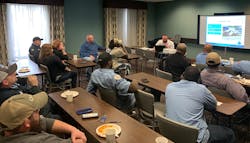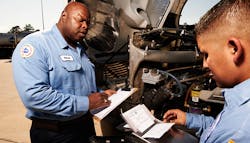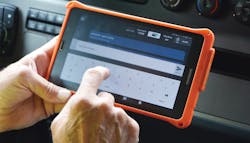From the trucks on the road to the back office, successful fleets find ways to stay ahead of the technology curve. That requires investments not only on equipment and software, but also ongoing training for drivers and other employees.
“There’s no such thing as trucking companies without being technology companies anymore,” said Scott Groff, director of training for Trimble Transportation. “Technology is involved in exponentially more pieces and parts of the process than we probably could’ve conceived six, seven years ago. I think the evolution of technology has sped ahead of the evolution of training.”
As a result, fleets are spending “a lot more time on training to achieve and maintain efficiency,” said David Custred, vice president of operations at McLeod Software.
Custred said it is important to provide multiple training options: self-paced learning, web-based learning, and on-site, classroom-style education.
“You need to do major training every three months, and you need to schedule weekly and monthly continuing training,” Custred said. “Ten years ago, we would’ve just trained the IT person. You can’t do that today. You’ve got to train the fleet manager and other key users who can teach everybody else. That’s the best investment you can make.”
While the larger fleets are likely to have training programs in place, it is more difficult for the small carriers that make up the majority of the industry, said Robert Haag, president of Perfect Transportation, which is based in Indianapolis and runs 45 trucks.
“I don’t think IT training is something that takes place broadly in the industry,” said Haag, chairman of the American Trucking Associations’ Technology and Engineering Policy Committee.
That is a problem because of the changing nature of the business. “The days are long gone where the only tool you needed in the service bay was a hammer to bang on things to get ‘em working,” he sad. “Nowadays, you open the hood and you can’t tell what’s wrong. You have to get on the computer. [But] how do you purge yourself of something when you’re not quite sure what you’re looking for?”
Tammy Ford worked in the IT space prior to joining Matheson Inc. as chief financial officer about two years ago. She sees the differences in IT knowledge among different fleets.
“There’s a big gap between the big guys who have a lot of technology and the little guys who are still kind of doing it on the backs of napkins,” she said.
Even among individual employees, there often is a divide between those who are comfortable with IT and those who aren’t.
“The concern we have is for the drivers who watch the video in the driving room, are embarrassed to say they didn’t get it, and then walk out to their trucks and have no idea what to do,” said Groff of Trimble.
He said smaller fleets may not have a director of training and rely on a safety manager or driver manager.
“The result is a rushed explanation [of training]. One way we address that is using things that drivers are starting to get more comfortable with, like YouTube. We put the instruction videos on there and ask the driver manager to have the drivers sit down and watch them in the break room.”
A similar struggle can often play out in the maintenance shop.
“Some [technicians] just want to work on equipment and they’re not interested in [computers and data],” said Kirk Altrichter, vice president of fleet services at Kenan Advantage Group, which has about 7,000 trucks. “Others want to continue and advance [their careers], but I still need that first group and so do all the other trucking companies.”
The rapid pace of changes means fleets need to continue IT training as they modernize. “It’s a significant retraining experience,” said Elise Fournet, who’s spearheading training at Dupré Logistics. The Louisiana-based hazmat transporter was an early adopter of technology but faces hurdles similar to many other fleets. “Our average driver is in his early 50s. They like their flip phones. They’ve had a unit in their cabs for as long as they’ve worked for Dupré, but the new one does things differently.
“I’ve found that changing tech is as difficult as brand-new tech,” he continued. “Like going from a paper log to an ELD is a little easier because there’s no context. Drivers don’t have a rhythm from another device.”
To help with the transition, Dupré teaches new technology first to terminal and safety managers, who then teach it to drivers. “They coach drivers all day long so that when it’s time for a tech change, we definitely leverage their ability to train and coach,” Fournet said. “We hand them the technology and say, ‘While you’re talking about all those other things, add this to the mix.’ ”
Truckload carrier Schneider has about 20 times as many trucks as Dupré’s 550, but the company deals with IT training in a similar fashion. According to Mike DeGeneffre, Schneider’s vice president of solution delivery and telematics, the ubiquity of smartphones has reduced the IT learning curve.
“People are inherently familiar with how to use smartphones and tablets,” DeGeneffre said. “When we do [an update], we provide notes so that our drivers know the functionality that’s being added or the defects that are being fixed. And we have videos and training manuals that we can deliver through the tablets. We have had some drivers who came from flip phones to the tablets. They took the most time to get comfortable, but any driver who needs help will get it. No driver is left to just learn it via the manuals and videos.”
Dispatchers are another critical group that require training. At Dupré, there are 75 dispatchers spread over its three divisions and a full-time trainer.
“[Trimble] gives us an instruction sheet or video, but if you just train somebody with that, they’re not ready to be customer service reps,” Fournet explained. “If you just teach the software, you’re really not giving your people exactly what they need. Customers are usually going to give X, Y and Z, but how do you find Z if they didn’t give it to you? What are our standard operating procedures for taking orders? If you teach those together, they remember the software side better. It’s a big investment in time, but where it used to take six months to get someone ready to be a solo dispatcher, now, it takes four to six weeks.”
Looking ahead, Fournet said the most successful fleets will be those that embrace IT.
“The era of looking at your business at the end of the month is over,” she said. “In 10 years, looking at your business at the end of the day isn’t going to be fast enough. The people who can take advantage of the data they have in a real-time fashion are going to be the ones with the edge. The people who can figure out how to aggregate and analyze that data in an automated way will be able to see the downturns before they happen. They’ll see the opportunities for higher margins in certain areas.”






